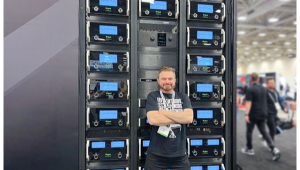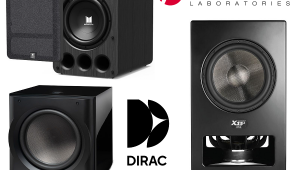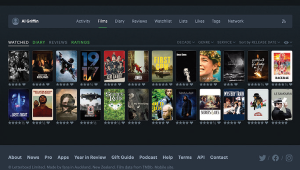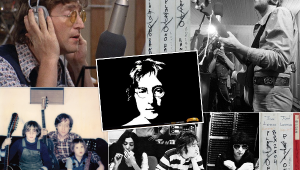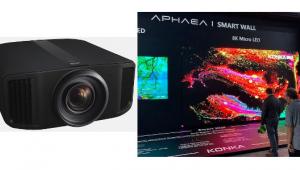It was quite the scene over there and the energy level was already pretty high.
Behind The Scenes at the Grammys

It was quite the scene over there and the energy level was already pretty high. The stage was fully built, all the technical infrastructure to send audio and video signals around the facility and out to the world was in place, and a good smattering of media personnel were already on hand and milling about the press rooms. Over the next few days, all 21 of the performing artists would be cycled through the stage for their 1.5 hour rehearsals, and the veritable army behind them — it takes an estimated 400 people to pull off the show — would go about their work behind the scenes to insure that the live broadcast would come off without a hitch. It was fascinating to see how the show, which has been done exclusively at the Staples Center since 2004, comes together.
All The Pieces in Place
With nearly a decade of experience working the show at Staples, the Recording Academy, CBS, and their production partners have pretty much nailed the puzzle placement of equipment and the procedural flow. A ramp area at the back of the Staples Center with truck access and open warehouse space functions as kind of an epicenter for the audio and video production teams and served as entry point for my tour. Here’s a little bit of what I saw. (Apologies in advance for the limited photographs; I was highly restricted in what I could shoot, and no images of the stage area itself were allowed.)
Divided Stage: It’s not immediately obvious to viewers at home, but the show stage set up at one end of the arena is broken into two main sections dubbed the A Stage and B Stage. Each has a barricade that comes down on wires in the manner of a curtain to block the house audience’s view of that stage. Television viewers will occasionally see a wide view of the stage with both barricades down during speeches and awards presentations (see this story’s lead image of last year’s Grammys), during which set up is probably taking place for the next live performance. Music performances can take place on one stage or the other, or both. There's also the C Stage, which is the platform out in the audience. The dual-sided main stage is used to great effect during rehearsals to speed that process (more on that below).
Audio Trucks: Two audio trailers that handle the 5.1-channel mix for the broadcast are situated immediately outside the Staples Center in a secure parking area. They are perfectly mirrored trucks, each containing a DigiDesign 32-fader mixing console running version HD6 of the industry-standard Pro Tools editing system. Mounted Genelec powered studio monitors and a powered subwoofer beneath the console are used for speakers. Adding the second truck a few years back greatly improved the efficiency of rehearsals and allowed the show’s producers to put more acts in the line-up. Typically, during an artist’s assigned rehearsal period, he or she will run through their song three times while the artist’s production representative sits with the show’s mixing engineer in the first truck. Together, they’ll come up with a good rough balance of the various mics used; there can be as many as 50 or 60 mic inputs for any given performance, some ganged together on one of the console’s 32 faders. Ultimately, upwards of 800 microphone inputs must be balanced throughout the course of the broadcast.
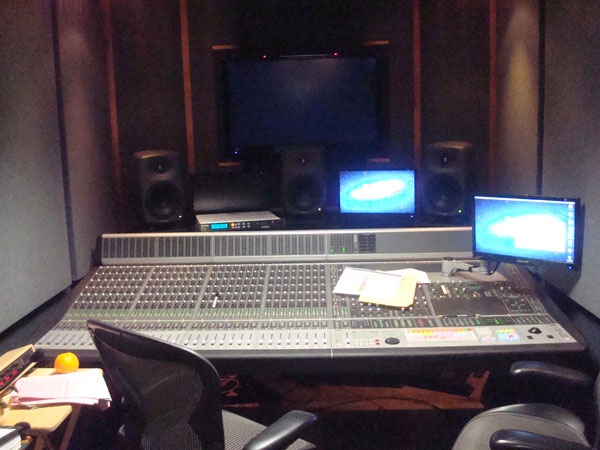
One of two identical DigiDesign 32-track mixing consoles used for the Grammy Awards.
Immediately following the rehearsal period, the artist’s rep moves into the second truck, where he and another engineer work off a recording of the rehearsal to fine-tune the balance, EQ, compression, and effects settings and place them in memory to use as a starting point for the live show performance. While that’s happening, another artist will have already begun his rehearsal on the opposite stage as their own production representative sits in the first truck to block out that performance before moving on to the second truck to finalize the mix. In this way, the show producers are able to schedule more than 20 performance rehearsals into a three-day period, along with the extra time required to rehearse speeches and presentations. During the live show, the second truck sits mostly idle, acting as a backup in the unlikely event of equipment failure in the first.
The Grammy Awards was among the first major awards shows to utilize 5.1-channel sound after the introduction of digital broadcasting. Though the engineers are typically live-monitoring the two-channel stereo feed in the trucks during the actual broadcast as the one most people will be hearing, the Recording Academy takes pride in the fact that they’ve engaged individuals around the country—about a half dozen in all—to monitor the end listener’s experience in qualified multichannel home theater environments. Everything with the audio mix may seem to be fine as it leaves the Staples Center through the satellite uplink and heads to the CBS broadcast center and then on to the cable, satellite, and broadcast station head-ends, but having people in the field can quickly identify undetected issues anywhere in the chain.
Pro Tools Trailer: Although the performances are live, additional pre-edited instrument and effects tracks are often layered in. In another trailer situated down the ramp and alongside the broadcast trucks is an engineer whose whole responsibility is cueing up these ancillary backup tracks required for the performances.
Broadcast Truck: Inside the warehouse area is another pair of large trailers that house the broadcast equipment, including a full television control room in one trailer (broken into the traditional audio and video sections) and most of the required infrastructure equipment in the other. The director will sit here during the show, working alongside the technical director to select any one of the show’s 18 cameras in real time, though during rehearsals he can be found out in the audience area in the arena, sitting at a folding table with a monitor and blocking out shots via intercom back to the control room. During the show, the video is melded here with the audio coming from the mix trucks before being sent on to the satellite uplink.
Wireless mic area: For any given performance, a combination of wired and wireless performance mics will be used. Simultaneous with the broadcast, multiple wireless intercom systems are used by various production and technical teams. Each wireless mic or intercom requires its own dedicated transmission frequency, so management of the spectrum inside the arena is no small matter.
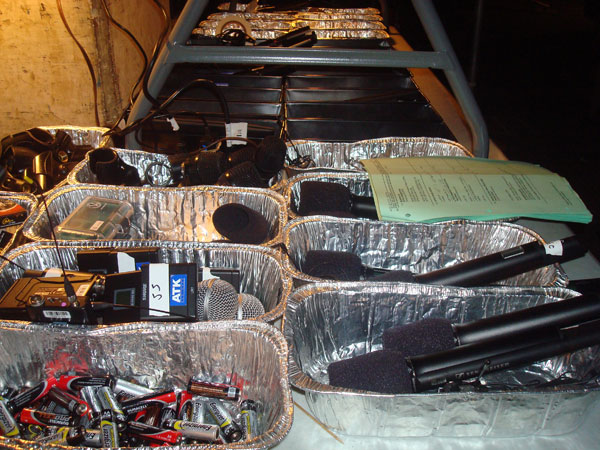
Wireless mics for individual performers are assigned dedicated frequencies and stored in metal tins until they’re ready for use on stage.
More than 200 frequencies need to be specifically assigned, and when artists bring in their own mics and equipment, conflicts inevitably surface that must be worked out during the rehearsal period. This is handled by a pair of engineers set up at some makeshift folding tables in a passageway beside the arena. Here you’ll find racks with all the wireless receivers (connected to 30 antennas scattered around the arena in five zones), as well as metal tins with the dedicated microphones assigned to each performer. The metal containers keep their signals arrested until they’re ready to be used. These mics are collected and brought on stage immediately before each performance to insure the right frequencies and mics are utilized.
Miscellaneous: I could go on and on here, for example, about the riser area created in the warehouse and on the ramp leading up to the stage in which every act builds dedicated risers in advance of the show upon which are placed their drum kits and other instruments; these are simply rolled on and off the stage as needed to speed set-up times. There are all kinds of personnel situated around the arena itself to mix and manage the house audio (played through JBL Vertec speaker arrays driven by Crown amplifiers), the lighting, and the teleprompter. Then there’s the makeshift instrument repair shop tucked away in what normally functions as the arena’s office for National Hockey League officials, where manufacturers of guitars and various other instruments stack up just-in-case backups for the individual performers, each labeled for the artist in the event it needs to be pulled into action. There’s a pavilion set up backstage in the dressing room area for MusiCares, the Academy’s charity for aging and disabled musicians, where the performers are politely asked to autograph instruments used later for charity auctions. And let’s not even get into the team of public relations experts charged with ushering the Grammy winners through a gauntlet of radio, TV, Web, and print reporters. And…so on.
Then, There’s The People
Despite the incredible array of technology and the brilliant logistics that go into the execution of the Grammy awards show, there’s no question in my mind that the most impressive element is the team of talented individuals who run the show. Many of those I met have worked on the show year after year, and are absolutely at the top of their professions; most are freelancers, and several will move on from the Grammys right into the Academy Awards. My thanks to those who took time from their hectic day to explain to me what they do and how this exciting broadcast comes together. I’ll never watch the Grammys again without seeing all of them behind the scenes.
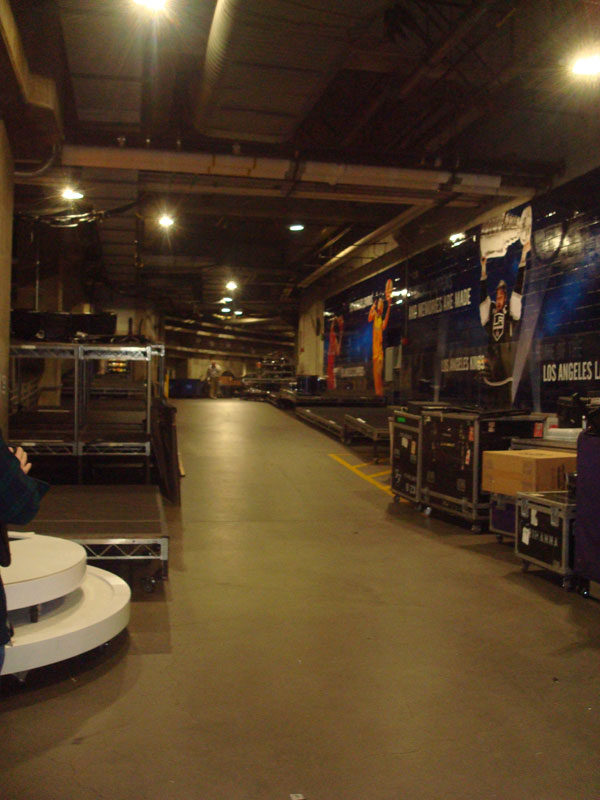
This warehouse and ramp leading up to the stage is filled on show day with risers with each band’s instruments, ready to be rolled quickly into place. Below, spare instruments for individual artists are organized in a makeshift repair area.
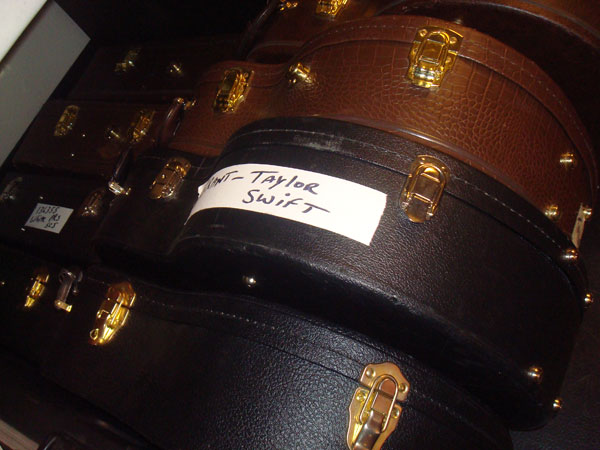
- Log in or register to post comments



